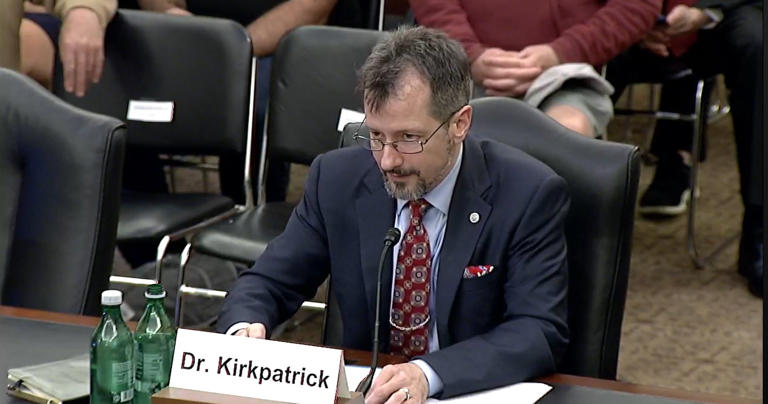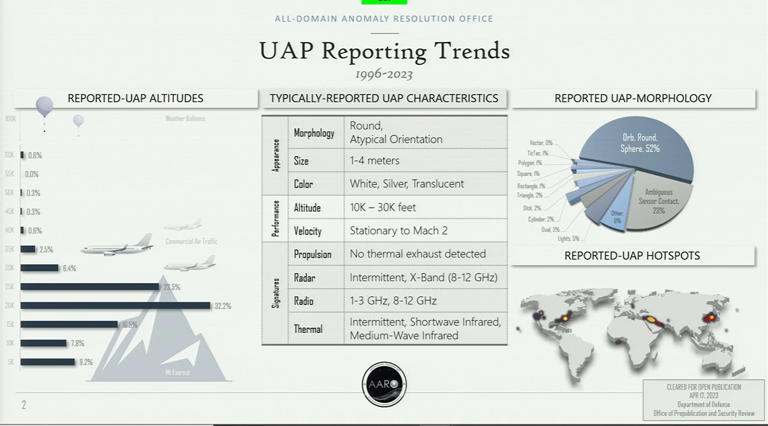Story by Sam Riches • Wednesday

Koller auction house director Cyril Koller gestures next to the skull of 'Trinity' prior to the sale of the skeleton of the Tyrannosaurus-Rex (T-Rex) by Koller auction house in Zurich, on April 18, 2023
A Tyrannosaurus rex skeleton, comprised of nearly 300 bones excavated from three different sites, was recently purchased for 4.8 million francs (about $7.2 million) at an auction in Switzerland.
The skeleton, which measures 11.6 meters long and 3.9 meters high, had been expected to fetch between $7.5 million to $12 million, reports The Associated Press.
According to the Koller auction house in Zurich, the sale marked the first time a T. rex skeleton was auctioned in Europe and only the third time worldwide that a T. rex skeleton of “exceptional quality” had been up for sale.
The skull of the T. rex, dubbed “Trinity,” remained next to the podium all day as more than 70 lots went under the hammer.
Koller told AP the skull was particularly rare and well-preserved. So why the drop in price?
Lawren Harris paintings sell for $1.2M each in record-breaking Paul Allen collection auction
“It could be that it was a composite — that could be why the purists didn’t go for it,” said Karl Green, the auction house’s marketing director. “It’s a fair price for the dino. I hope it’s going to be shown somewhere in public.”
Vertebrate paleontologist Thomas Holtz told AFP that Trinity, which is made up of bones from three dinosaurs excavated between 2008 and 2013, “really isn’t a ‘specimen’ so much as it is an art installation.”
The buyer, identified only as a European private collector, was also on the hook for additional fees, like the “buyer’s premium,” which pushed the final sales price to 5.5 million francs (about $8.2 million.)
Trinity was built from bones found at sites in the Hell Creek and Lance Creek formations of Montana and Wyoming.
The same areas were also home to T. rex skeletons that have been auctioned for substantially higher prices, including Stan, the most expensive fossil ever sold. At more than 70 per cent complete, Stan sold for US$31.8 million at auction in October 2020.
Stan was out of the public eye for more than two years, and some researchers began to fear it would remain that way, until it was announced last March that Stan would have a new home at a natural history museum in Abu Dhabi , which is slated to open in 2025.
In 1997, another T. rex, named Sue, sold for about $8.5 million at an auction in New York. Sue is currently on display at Chicago’s Field Museum of Natural History and is the largest and most complete T. rex skeleton ever found, at around 90 per cent complete by bone volume.
Sue contains 250 of the approximately 380 known bones in the T. rex skeleton, and a team of museum preparators spent more than 50,000 hours preparing the skeleton and building the exhibit.
Sue Hendrickson unearthed the specimen during a commercial excavation trip to South Dakota in 1990.
Big John, the largest known Triceratops skeleton, went for $7.7 million at an auction in Paris in 2021 . Big John was discovered in the Hell Creek Formation in 2014.
Last year, a T. rex dubbed Shen was expected to sell for between $21 and $34 million in Hong Kong before questions about its authenticity led to the auction being called off .
Peter Larson of U.S. fossil company, Black Hills Institute of Geological Research, noted that Shen had similar features to Stan, mainly holes in the lower left jaw. Despite the sale of Stan, the company retains intellectual property rights and sells polyurethane casts of the skeleton for about $16,000.
Larson told the New York Times that he believes Shen’s owner purchased the cast from his company to replace some of the missing original bones.
Christie’s auction house later pulled the listing and said in a statement that Shen was on loan to a museum.
Despite Trinity’s less-than-expected price tag, auctioneer Cyril Koller told AFP that the event was a success, as the skeleton was displayed for two-and-a-half weeks in the concert hall in Zurich and attracted more than 30,000 visitors.
The lowered price point might also be a good thing for science, as experts warn that soaring dinosaur prices may cause such specimens to end up in the hands of private collectors and limit research opportunities and public viewings.
That doesn’t seem to be the case for Trinity, according to Koller.
“I’m 100 per cent sure we will see Trinity in the future somewhere again,” he said.





















